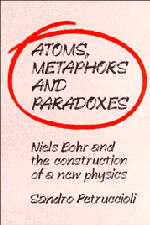Book contents
- Frontmatter
- Contents
- Introduction
- 1 The paradigm of complementarity
- 2 Atomic model and quantum hypotheses
- 3 The principle of correspondence
- 4 The theory of virtual oscillators
- 5 The conceptual foundation of quantum mechanics
- 6 The Bohr—Einstein confrontation: phenomena and physical reality
- General bibliography
- Name index
- General index
6 - The Bohr—Einstein confrontation: phenomena and physical reality
Published online by Cambridge University Press: 10 November 2009
- Frontmatter
- Contents
- Introduction
- 1 The paradigm of complementarity
- 2 Atomic model and quantum hypotheses
- 3 The principle of correspondence
- 4 The theory of virtual oscillators
- 5 The conceptual foundation of quantum mechanics
- 6 The Bohr—Einstein confrontation: phenomena and physical reality
- General bibliography
- Name index
- General index
Summary
As Quine wrote in 1961, what strikes us in a paradox is its initial air of absurdity, which develops into a sort of psychological discomfort when we compare the conclusions of the reasoning with the apparently irrefutable arguments on which it is based. However, as he went on to observe, ‘More than once in history the discovery of paradox has been the occasion for major reconstruction at the foundations of thought’. Catastrophe may therefore lurk even in the most innocent-seeming of paradoxes and force us to recognize the arbitrary nature ‘of a buried premise or of some preconception previously reckoned as central to physical theory, to mathematics or to the thinking process’. More recently, ideas of this kind have been used to assert in general that the role of paradox in the growth of knowledge is to generate category switches and to construct new universes of discourse. It could also be argued that paradoxes constitute elements of the logic of discovery capable of amplifying and thus making intelligible the still obscure phases accompanying paradigm shifts. Paradoxes would thus represent points of accumulation for the tension created between a given system of conceptual representation and a theory or empirical discovery that violates it.
Historians of science have tried different interpretative approaches in their attempts to unravel the thought process that was to lead Einstein in 1905 to the formulation of special relativity and the simultaneous demolition of the classical conception of space and time.
- Type
- Chapter
- Information
- Atoms, Metaphors and ParadoxesNiels Bohr and the Construction of a New Physics, pp. 183 - 217Publisher: Cambridge University PressPrint publication year: 1993



